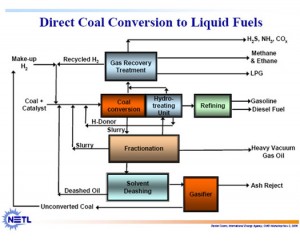شرکت پژوهش های علمی وصنعتی زرین کار طلایی آمادگی خود را برای صنعتی سازی این پروژه اعلام میکند.
Coal liquefaction is the production of liquid fuels from coal using a variety of industrial processes. Specific liquefaction technologies generally fall into two categories: direct (DCL) and indirect liquefaction (ICL) processes. Indirect liquefaction processes generally involve gasification of coal to a mixture of carbon monoxide and hydrogen (syngas) and then using a process such as Fischer–Tropsch process to convert the syngas mixture into liquid hydrocarbons. By contrast, direct liquefaction processes convert coal into liquids directly, without the intermediate step of gasification, by breaking down its organic structure with application of solvents or catalysts in a high pressure and temperature environment. Since liquid hydrocarbons generally have a higher hydrogen-carbon molar ratio than coals, either hydrogenation or carbon-rejection processes must be employed in both ICL and DCL technologies.
As coal liquefaction generally is a high-temperature/high-pressure process, it requires a significant energy consumption and, at industrial scales (thousands of barrels/day), multi-billion dollar capital investments. Thus, coal liquefaction is only economically viable at historically high oil prices, and therefore presents a high investment risk.

